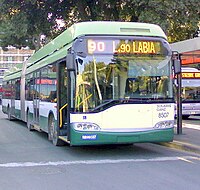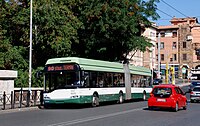
The Rome Metro is a rapid transit system that operates in Rome, Italy. It started operation in 1955, making it the oldest in the country.

The Boston-area trolleybus system formed part of the public transportation network serving Greater Boston in the U.S. state of Massachusetts. It opened on April 11, 1936, with a large network operating for the next quarter-century. Measured by fleet size, the Boston-area system was the second-largest trolleybus system in the United States at its peak, with only the Chicago system having more trolleybuses than Boston's 463. After 1963, the only remaining portion was a four-route cluster operating from the Harvard bus tunnel at Harvard station, running through Cambridge, Belmont, and Watertown. The Massachusetts Bay Transportation Authority took over the routes in 1964.

The current tram system in Rome, Italy, is a leftover from what once was the largest tram system in Italy. With its fragmented structure, it does not currently function as a backbone of the city's public transport. The system is owned and operated by Azienda Tranvie e Autobus del Comune di Roma.
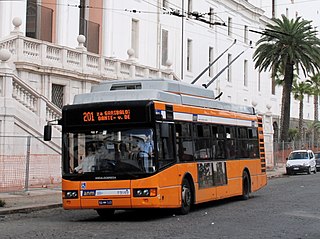
Trolleybuses in Naples provide a portion of the public transport service in the city and comune of Naples, in the region of Campania, southern Italy. From 1964 to 2015, two independent trolleybus systems were in operation, both publicly owned, but only that of Azienda Napoletana Mobilità (ANM) remains in operation. The ANM system opened in 1940, whereas the smaller trolleybus network of Compagnia Trasporti Pubblici di Napoli (CTP) opened in 1964.
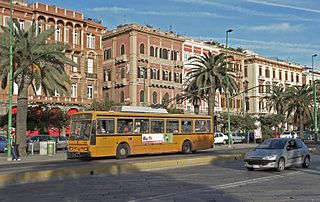
The Cagliari trolleybus system forms part of the public transport network of the city and comune of Cagliari, in the region of Sardinia, Italy.
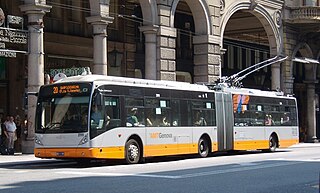
The Genoa trolleybus system forms part of the public transport network of the city and comune of Genoa, in the region of Liguria, northern Italy. In operation since 1997, the system currently comprises only one route. Between 2008 and 2012, two routes were being operated.

The Parma trolleybus system forms part of the public transport network of the city and comune of Parma, in the region of Emilia-Romagna, northern Italy. In operation since 1953, the system presently comprises four urban routes.

The Sanremo trolleybus system or San Remo trolleybus system, also known as the Italian Riviera trolleybus, is focused on the town and comune of Sanremo, in the region of Liguria, northwestern Italy.
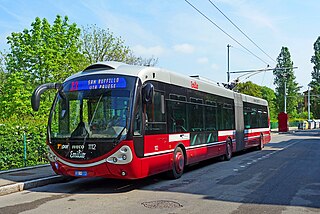
The Bologna trolleybus system is part of the public transport network of the city and comune of Bologna, in the region of Emilia-Romagna, northern Italy. While being in operation since 1991, the current system comprises five urban routes: 13, 14, 15, 32 and 33. Additional routes are presently under construction.

The Chieti trolleybus system forms part of the public transport network of the city and comune of Chieti, in the region of Abruzzo, central Italy. In operation since 2009, the system comprises one urban route.

The Modena trolleybus system forms part of the public transport network of the city and comune of Modena, in the region of Emilia-Romagna, northern Italy.

The Seattle trolleybus system forms part of the public transportation network in the city of Seattle, Washington, operated by King County Metro. Originally opened on April 28, 1940, the network consists of 15 routes, with 174 trolleybuses operating on 68 miles (109 km) of two-way parallel overhead lines. As of the third quarter of 2023, the system carries riders on an average of 40,300 trips per weekday, comprising about 18 percent of King County Metro's total daily ridership. At present in Seattle, a very common alternative term for trolleybus is trolley.

The Rimini trolleybus system forms part of the public transport network of the Province of Rimini, in the region of Emilia-Romagna, Italy.

The La Chaux-de-Fonds trolleybus system forms part of the public transport network in La Chaux-de-Fonds, in the canton of Neuchâtel, Switzerland.
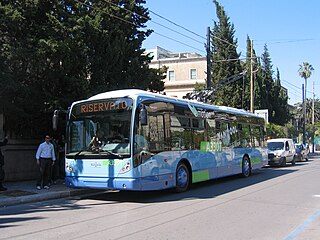
The Lecce trolleybus system forms part of the public transport network of the city and comune of Lecce, in the Apulia region, southern Italy.

ATAC S.p.A. is an Italian publicly owned company running most of the local public transportation services, paid parking and incentive parking lots in Rome. More specifically, the company handles, on behalf of Roma Capitale Authority, the entire tramway, trolleybus network and metro lines, as well as most of the bus lines in the city. It also operates, on behalf of the Administrative Region of Lazio, three railways: Roma-Civita Castellana-Viterbo, Roma-Giardinetti and Roma-Lido. ATAC S.p.A., with its 2,200-kilometer-wide public transport network, its over 8,500 busses and 70,000 parking stalls, is currently one of the biggest public transportation companies in Europe and the largest in Italy.

Trieste's trolleybus system was operational from 1935 until 1975.

BRT Marrakesh is a bus rapid transit system that is also partly trolleybus in Marrakesh, Morocco. It opened on 29 September 2017. The system is officially known as Bus à Haut Niveau de Service de Marrakech, which equates to the English term Bus Rapid Transit, or BRT, of Marrakesh. Although the buses are equipped to operate as trolleybuses, only part of the system is fitted with overhead wiring for trolleybuses, and the vehicles operated on batteries over the other sections.

The Avellino trolleybus system forms part of the public transport network of the city of Avellino and the province of Avellino, in the region of Campania. Trolleybuses originally served the city from 1947 to 1973, on a route that also extended outside the city to the neighbouring towns of Atripalda and Mercogliano, and then the system closed. However, in the 2000s work to build a new trolleybus system got under way and new vehicles were purchased for it in 2007, and were delivered in 2014. The project experienced several delays after the start of construction in 2009, but most issues had been resolved by 2020 and construction was largely completed by 2021. Throughout its planning and construction, it was inaccurately referred to as the "metropolitana leggera", when in fact it was never planned to be a rail line, and always planned to be a trolleybus line. The last round of testing took place in December 2022 and January 2023, and the new trolleybus system opened for service on 3 April 2023.



